radio BUICK REGAL 1998 Owner's Manual
[x] Cancel search | Manufacturer: BUICK, Model Year: 1998, Model line: REGAL, Model: BUICK REGAL 1998Pages: 388, PDF Size: 20.19 MB
Page 180 of 388
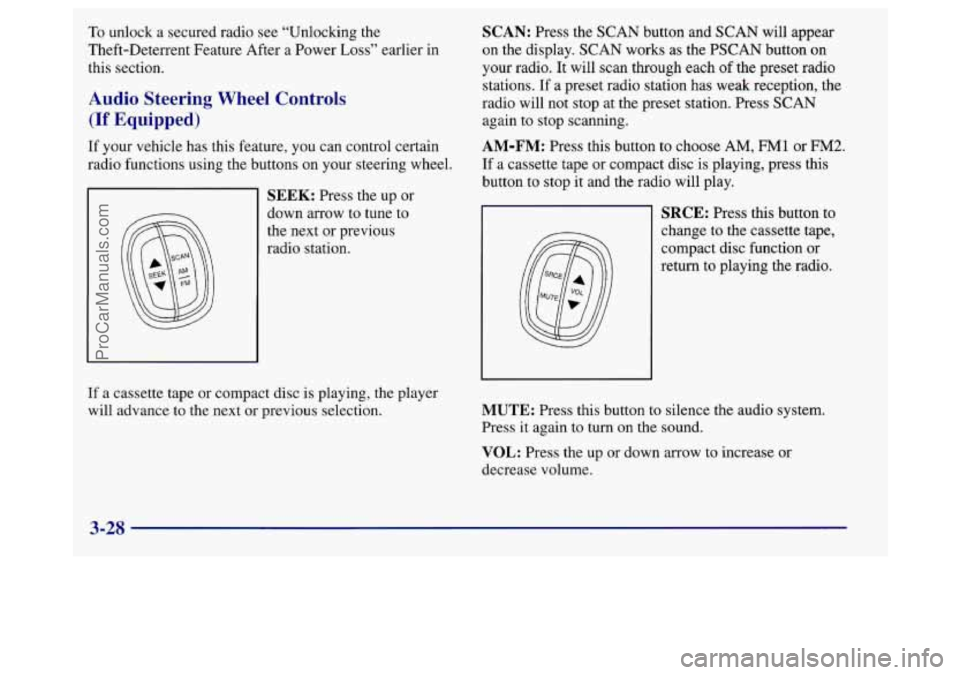
To unlock a secured radio see “Unlocking the
Theft-Deterrent Feature After a Power
Loss” earlier in
this section.
Audio Steering Wheel Controls
(If Equipped)
If your vehicle has this feature, you can control certain
radio functions using the buttons on your steering wheel.
SEEK: Press the up or
down arrow to tune to
the next or previous
radio station.
SCAN: Press the SCAN button and SCAN will appear
on the display. SCAN works as the PSCAN button on
your radio.
It will scan through each of the preset radio
stations. If a preset radio station has weak reception, the
radio will not stop at the preset station. Press SCAN
again to stop scanning.
AM-FM: Press this button to choose AM, FM1 or FM2.
If a cassette tape or compact disc is playing, press this
button to stop it and the radio will play.
SRCE: Press this button to
change to the cassette tape,
compact disc function or
return to playing the radio.
If a cassette tape or compact disc is playing, the player
will advance to the next
or previous selection. MUTE: Press this button to silence the audio system.
Press it again to turn on the sound.
VOL: Press the up or down arrow to increase or
decrease volume.
3-28
ProCarManuals.com
Page 181 of 388
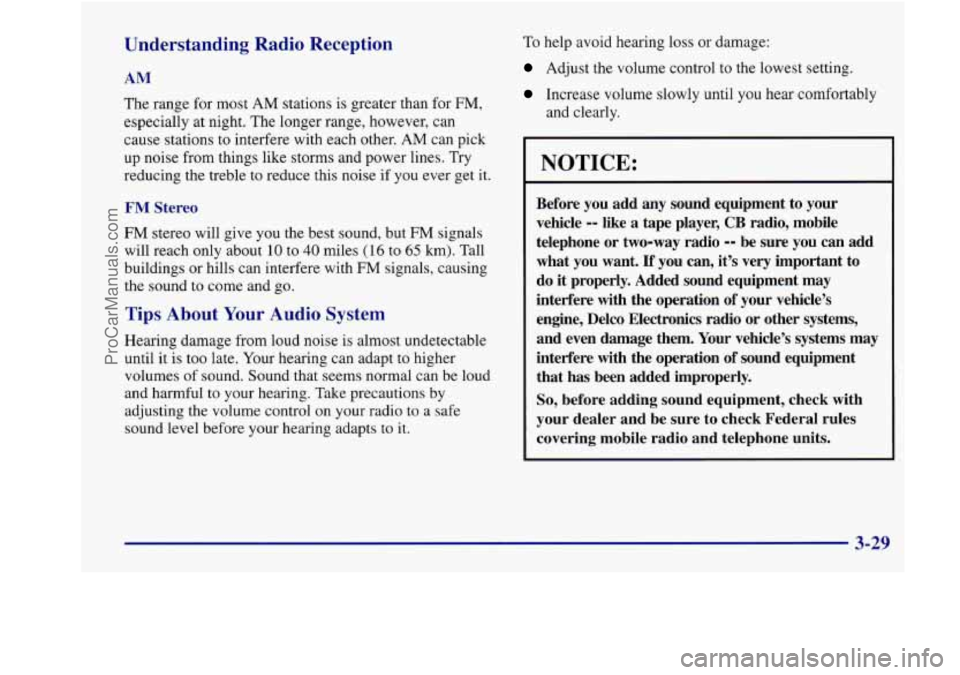
Understanding Radio Reception
AM
The range for most AM stations is greater than for FM,
especially at night. The longer range, however, can
cause stations to interfere with each other. AM can pick
up noise from things like storms and power lines.
Try
reducing the treble to reduce this noise if you ever get it.
FM Stereo
FM stereo will give you the best sound, but FM signals
will reach only about
10 to 40 miles (1 6 to 65 km). Tall
buildings or hills can interfere with FM signals, causing
the sound to come and go.
Tips About Your Audio System
Hearing damage from loud noise is almost undetectable
until
it is too late. Your hearing can adapt to higher
volumes
of sound. Sound that seems normal can be loud
and harmful to your hearing. Take precautions by
adjusting the volume control
on your radio to a safe
sound level before your hearing adapts to it. To
help avoid hearing loss or damage:
Adjust the volume control to the lowest setting.
Increase volume slowly until you hear comfortably
and clearly.
NOTICE:
Before you add any sound equipment to your
vehicle -- like a tape player, CB radio, mobile
telephone or two-way radio
-- be sure you can add
what you want.
If you can, it’s very important to
do it properly. Added sound equipment may
interfere with the operation of your vehicle’s
engine, Delco Electronics radio or other systems,
and even damage them. Your vehicle’s systems may
interfere with the operation of sound equipment
that has been added improperly.
So, before adding sound equipment, check with
your dealer and be sure
to check Federal rules
covering mobile radio and telephone units.
ProCarManuals.com
Page 182 of 388
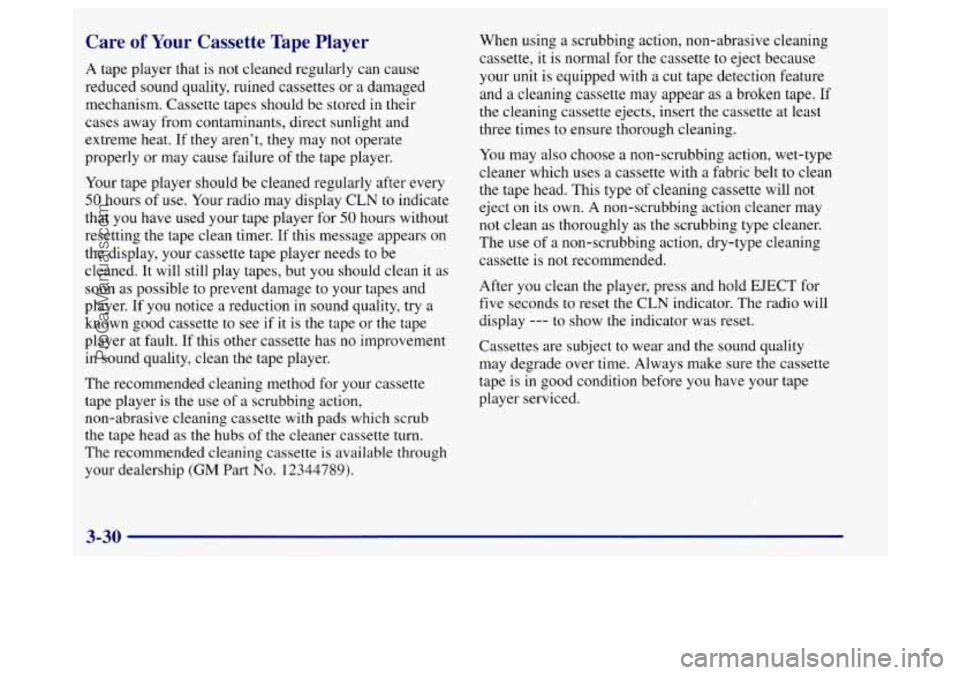
Care of Your Cassette Tape Player
A tape player that is not cleaned regularly can cause
reduced sound quality, ruined cassettes or a damaged
mechanism. Cassette tapes should be stored
in their
cases away from contaminants, direct sunlight and
extreme heat. If they aren’t, they may not operate
properly or may cause failure of the tape player.
Your tape player should be cleaned regularly after every
50 hours of use. Your radio may display CLN to indicate
that you have used your tape player for
50 hours without
resetting the tape clean timer. If this message appears on
the display, your cassette tape player needs to be
cleaned. It will still play tapes, but you should clean it as
soon as possible to prevent damage to your tapes and
player. If you notice a reduction in sound quality, try a
known good cassette to see if
it is the tape or the tape
player at fault.
If this other cassette has no improvement
in sound quality, clean the tape player.
The recommended cleaning method for your cassette
tape player is the use of a scrubbing action,
non-abrasive cleaning cassette with pads which scrub
the tape head as the hubs of the cleaner cassette turn.
The recommended cleaning cassette is available through
your dealership
(GM Part No. 12344789).
When using a scrubbing action, non-abrasive cleaning
cassette, it
is normal for the cassette to eject because
your unit is equipped with a cut tape detection feature
and a cleaning cassette may appear as a broken tape.
If
the cleaning cassette ejects, insert the cassette at least
three times to ensure thorough cleaning.
You may also choose a non-scrubbing action, wet-type
cleaner which uses a cassette with a fabric belt to clean
the tape head. This type of cleaning cassette will not
eject on its own. A non-scrubbing action cleaner may
not clean as thoroughly as the scrubbing type cleaner.
The use of a non-scrubbing action, dry-type cleaning
cassette is not recommended.
After you clean the player, press and hold EJECT for
five seconds to reset the
CLN indicator. The radio will
display
--- to show the indicator was reset.
Cassettes are subject to wear and the sound quality
may degrade over time. Always make sure the cassette
tape is in good condition before you have your tape
player serviced.
ProCarManuals.com
Page 183 of 388
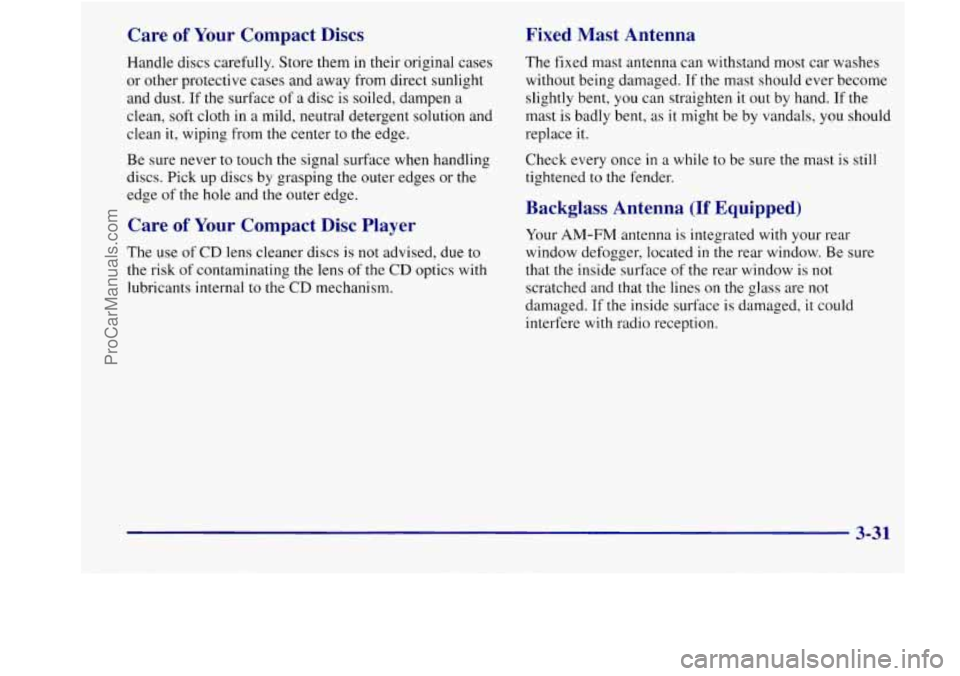
Care of Your Compact Discs
Handle discs carefully. Store them in their original cases
or other protective cases and away from direct sunlight
and dust.
If the surface of a disc is soiled, dampen a
clean, soft cloth in a mild, neutral detergent solution and
clean
it, wiping from the center to the edge.
Be sure never to touch the signal surface when handling
discs. Pick
up discs by grasping the outer edges or the
edge of the hole and the outer edge.
Care of Your Compact Disc Player
The use of CD lens cleaner discs is not advised, due to
the risk of contaminating the lens of the CD optics with
lubricants internal to the CD mechanism.
Fixed Mast Antenna
The fixed mast antenna can withstand most car washes
without being damaged.
If the mast should ever become
slightly bent, you can straighten
it out by hand. If the
mast is badly bent, as
it might be by vandals, you should
replace
it.
Check every once in a while to be sure the mast is still
tightened
to the fender.
Backglass Antenna (If Equipped)
Your AM-FM antenna is integrated with your rear
window defogger, located
in the rear window. Be sure
that the inside surface of the rear window is
not
scratched and that the lines on the glass are not
damaged.
If the inside surface is damaged, it could
interfere with radio reception.
3-31
ProCarManuals.com
Page 184 of 388
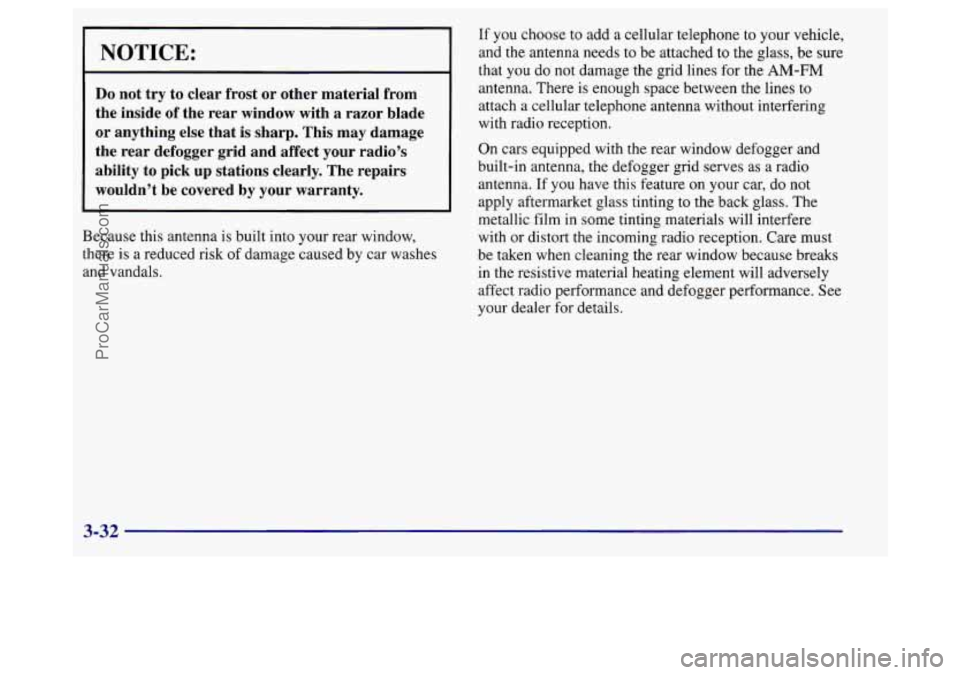
NOTICE:
Do not try to clear frost or other material from
the inside
of the rear window with a razor blade
or anything else that
is sharp. This may damage
the rear defogger grid and affect your radio’s
ability to pick up stations clearly. The repairs
wouldn’t be covered by your warranty.
~
Because this antenna is built into your rear window,
there is a reduced risk of damage caused by car washes
and vandals. If
you choose to add a cellular telephone
to your vehicle,
and the antenna needs to be attached to the glass, be sure
that you do
not damage the grid lines for the AM-FM
antenna. There is enough space between the lines to
attach
a cellular telephone antenna without interfering
with radio reception.
On cars equipped with the rear window defogger and
built-in antenna, the defogger grid serves as a radio
antenna. If you have this feature on your car, do not
apply aftermarket glass tinting to the back glass. The
metallic film in some tinting materials will interfere
with or distort the incoming radio reception. Care must
be taken when cleaning the rear window because breaks in the resistive material heating element will adversely
affect radio performance and defogger performance. See
your dealer for details.
3-32
ProCarManuals.com
Page 230 of 388
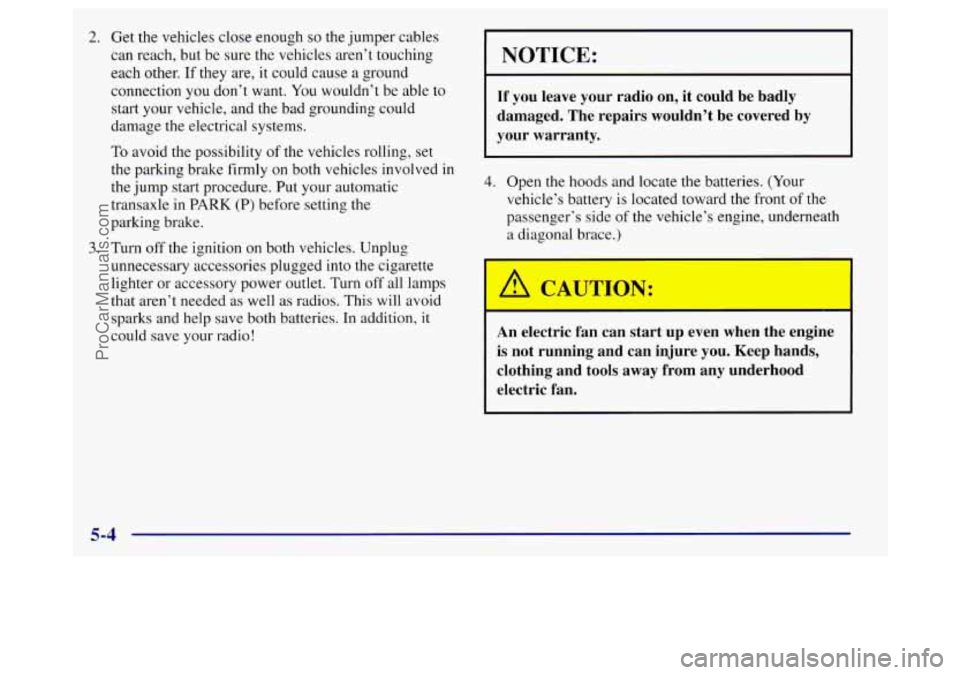
2. Get the vehicles close enough so the jumper cables
can reach, but be sure the vehicles aren’t touching
each other. If they are, it could cause
a ground
connection you don’t want. You wouldn’t be able to
start your vehicle, and the bad grounding could
damage the electrical systems.
To avoid the possibility of the vehicles rolling, set
the parking brake firmly on both vehicles involved in
the jump
start procedure. Put your automatic
transaxle in
PARK (P) before setting the
parking brake.
3. Turn off the ignition on both vehicles. Unplug
unnecessary accessories plugged into the cigarette
lighter
or accessory power outlet. Turn off all lamps
that aren’t needed as well
as radios. This will avoid
sparks and help save both batteries. In addition, it
could save your radio!
NOTICE:
If you leave your radio on, it could be badly
damaged. The repairs wouldn’t
be covered by
your warranty.
4. Open the hoods and locate the batteries. (Your
vehicle’s battery is located toward the front
of the
passenger’s side
of the vehicle’s engine, underneath
a diagonal brace.)
An electric fan can start up even when the engine
is not running and can injure you. Keep hands, clothing and tools away
from any underhood
electric fan.
5-4
ProCarManuals.com
Page 327 of 388
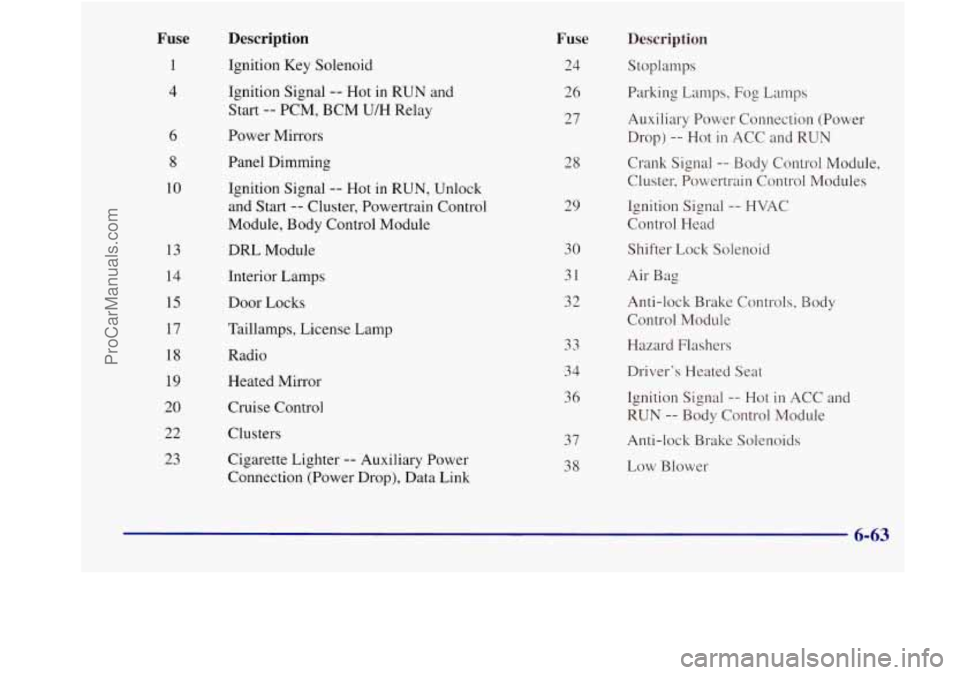
Fuse
1
4
6
8
10
13
14
15
17
18
19
20
22
23
Description
Ignition Key Solenoid
Ignition Signal
-- Hot in RUN and
Start
-- PCM, BCM U/H Relay
Power Mirrors
Panel Dimming
Ignition Signal
-- Hot in RUN, Unlock
and Start
-- Cluster, Powertrain Control
Module, Body Control Module
DRL Module
Interior Lamps
Door
Locks
Taillamps, License Lamp
Radio
Heated Mirror
Cruise Control
Clusters
Cigarette Lighter
-- Auxiliary Power
Connection (Power Drop), Data Link
Fuse
24
26
27
28
29
30
31
32
33
34
36
37
38
Description
Stoplamps
Parking Lamps,
Fog Lamps
Auxiliary Power Connection (Power
Drop)
-- Hot in ACC and RUN
Crank Signal
-- Body Control Module,
Cluster, Powertrain Control Modules
Ignition Signal
-- HVAC
Control Head
Shifter Lock Solenoid
Air Bag
Anti-lock Brake Controls, Body
Control Module
Hazard Flashers
Driver’s Heated Seat
Ignition Signal
-- Hot in ACC and
RUN
-- Body Control Module
Anti-lock Brake Solenoids
Low Blower
6-63
ProCarManuals.com
Page 328 of 388
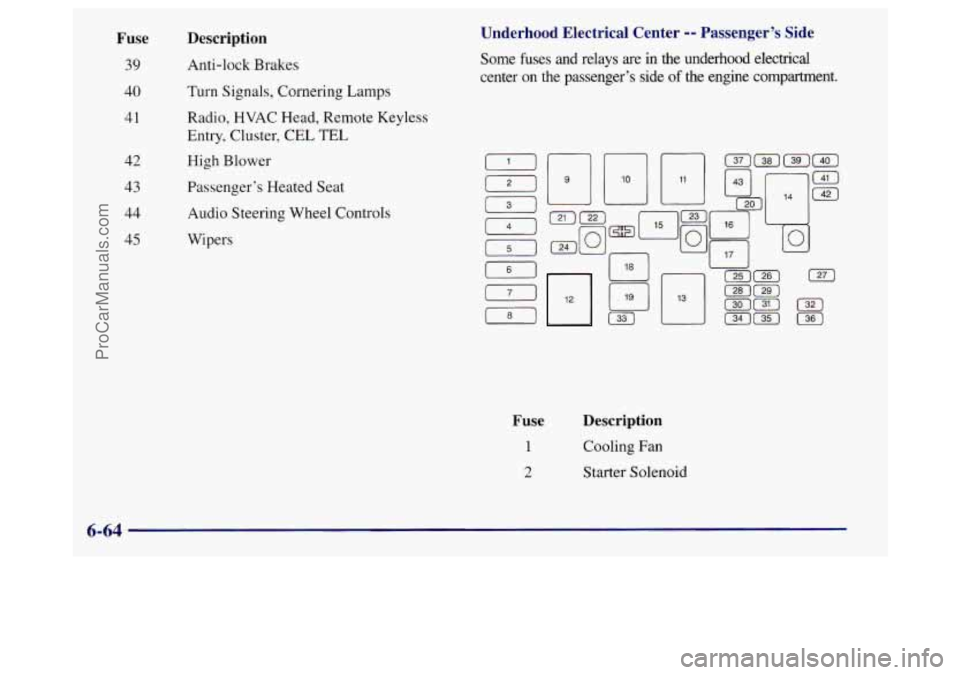
Fuse
39
40
41
42
43
44
45
Description
Anti-lock Brakes
Turn Signals, Cornering Lamps
Radio, HVAC Head, Remote Keyless
Entry, Cluster, CEL
TEL
High Blower
Passenger’s Heated Seat
Audio Steering Wheel Controls
Wipers
Underhood Electrical Center -- Passenger’s Side
Some fuses and relays are in the underhood electrical
center on the passenger’s side
of the engine compartment.
m
121
13)
14)
15)
(81
17)
[8)
Fuse
1
2
Description
Cooling Fan
Starter Solenoid
6-64
ProCarManuals.com
Page 329 of 388
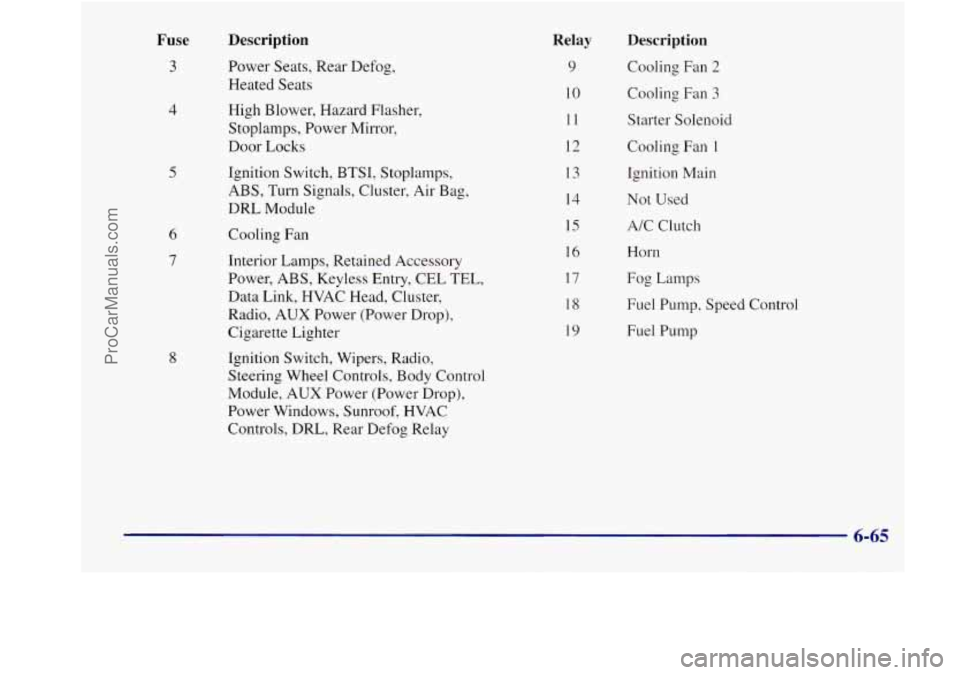
Fuse
3
4
5
6
7
8
Description
Power Seats, Rear Defog,
Heated Seats
High Blower, Hazard Flasher, Stoplamps, Power Mirror,
Door Locks
Ignition Switch, BTSI, Stoplamps,
ABS, Turn Signals, Cluster, Air Bag,
DRL Module
Cooling Fan
Interior Lamps, Retained Accessory
Power, ABS, Keyless Entry, CEL TEL,
Data Link, HVAC Head, Cluster,
Radio, AUX Power (Power Drop), Cigarette Lighter
Ignition Switch, Wipers, Radio,
Steering Wheel Controls, Body Control
Module, AUX Power (Power Drop),
Power Windows, Sunroof, HVAC
Controls, DRL, Rear Defog Relay
Relay
9
10
11
12
13
14
15
16
17
18
19
Description
Cooling Fan 2
Cooling Fan 3
Starter Solenoid
Cooling Fan
1
Ignition Main
Not Used
A/C Clutch
Horn
Fog Lamps
Fuel Pump, Speed Control
Fuel Pump
6-65
ProCarManuals.com
Page 373 of 388
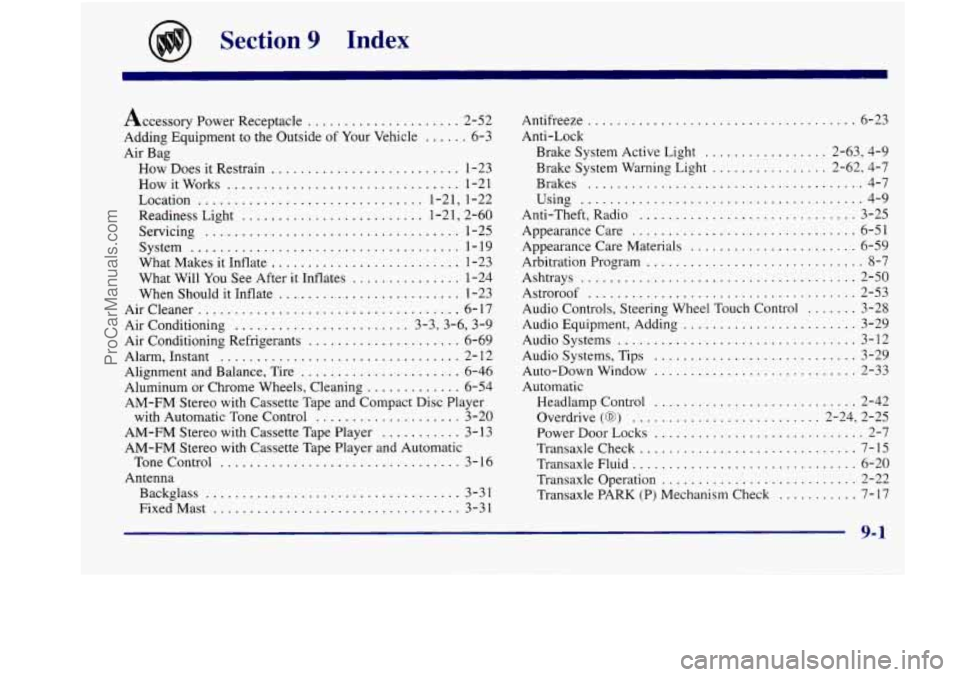
Section 9 Index
Accessory Power Receptacle ..................... 2-52
Adding Equipment to the Outside of Your Vehicle ...... 6-3
Air Bag How Does it Restrain
.......................... 1-23
How it Works
................................ 1-21
Location
............................... 1.21. 1-22
Readiness Light
......................... 1.21. 2.60
Servicing
................................... 1-25
System
..................................... 1-19
What Makes it Inflate
.......................... 1-23
What Will You See After
it Inflates ............... 1-24
When Should it Inflate
......................... 1-23
Aircleaner
.................................... 6-17
Air Conditioning
........................ 3.3.3.6. 3.9
Air Conditioning Refrigerants
..................... 6-69
Alarm. Instant
................................. 2- 12
Alignment and Balance. Tire
...................... 6-46
Aluminum or Chrome Wheels. Cleaning
............. 6-54
AM-FM Stereo with Cassette Tape and Compact Disc Player
with Automatic Tone Control
.................... 3-20
AM-FM Stereo with Cassette Tape Player ........... 3-13
AM-FM Stereo with Cassette Tape Player and Automatic
Tonecontrol
................................. 3-16
Antenna Backglass
................................... 3-31
FixedMast .................................. 3-31 Antifreeze
..................................... 6-23
Anti-Lock Brake System Active Light
................. 2.63. 4.9
Brake System Warning Light
................ 2.62. 4.7
Brakes ...................................... 4-7
Anti-Theft, Radio
.............................. 3-25
Appearancecare
............................... 6-51
Appearance Care Materials
....................... 6-59
Arbitration Program
.............................. 8-7
Ashtrays ...................................... 2-50
Astroroof
..................................... 2-53
Audio Controls, Steering Wheel Touch Control
....... 3-28
Audio Equipment, Adding ........................ 3-29
Audio Systems
................................. 3-12
Audio Systems, Tips
............................ 3-29
Auto-Down Window
............................ 2-33
Automatic
Headlamp Control
............................ 2-42
Overdrive
(a) .......................... 2-24, 2-25
Power Door Locks ............................. 2-7
Transaxlecheck .............................. 7-15
Transaxle Fluid
............................... 6-20
Transaxle Operation
........................... 2-22
Transaxle PARK (P) Mechanism Check
........... 7-17
Using
....................................... 4-9
9-1
.
ProCarManuals.com